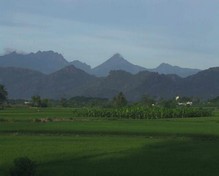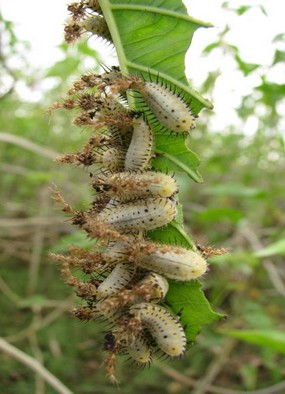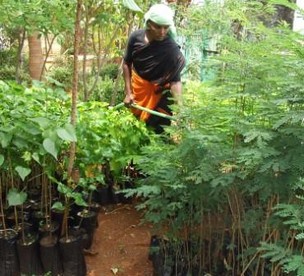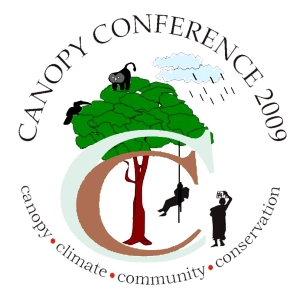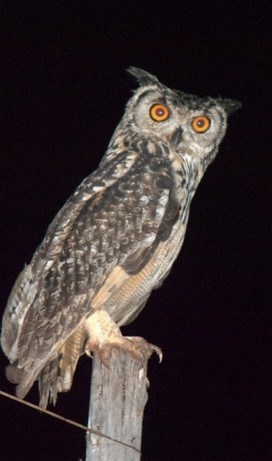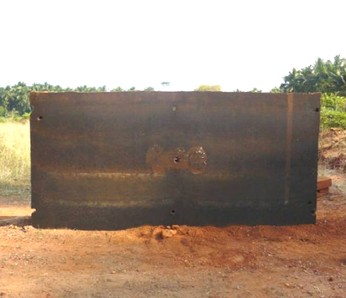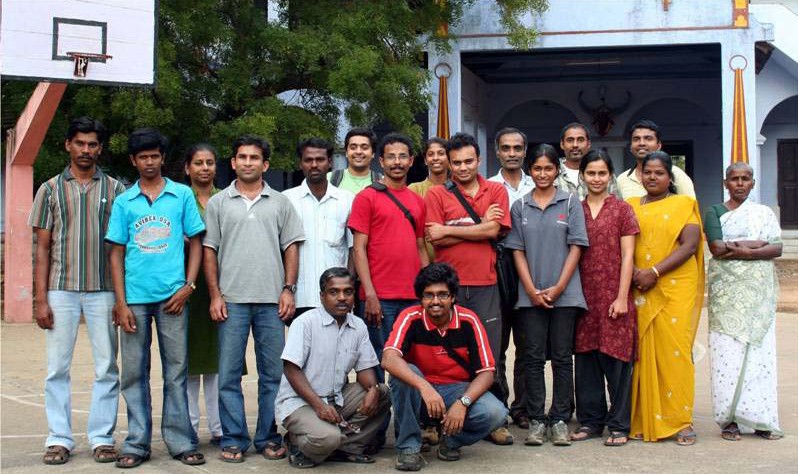Agasthya
A newsletter on the Natural History, Ecology
and Conservation of the Agasthyamalai region, Western Ghats, India.
Building stewardship for bird habitat
Though it was a winter sun, the heat was dehydrating. We were sampling for water birds in the wetlands around Alwarkurchi. We had finished a small tank and crossed over to another large pond. As we started recording the names of the birds, debating over what looked like a watercock, we chanced upon a large congregation of birds on acacia trees far beyond the green stretch of paddies and trees. After a brief rest, we headed for the acacias.
Under the bright afternoon light, we saw an awesome sight. Night herons, white ibis, cormorants all at nest on acacias inside a tank, large number of terns on a power line crossing the tank, egrets, herons, grebes, spotbills, Pelicans etc all over the place. It was a refreshing and delightful sight.
On making enquiries, we were told that the small village next to the tank was Nanalkulam and the tank was called Vagaikulam. The villagers also suggested we come in the evening to “see the birds come and roost in this place.” We also came to know that the acacias on which the birds were nesting and roosting were to be cut once the water level comes down.
On subsequent days, we followed up with the Panchayat presidents of Malik nagar and Mandiyur, who have control over this area. We contacted the conservator of forests, Tirunelveli, and gave him a report. He assured his best to prevent the felling. We informed the press and we organised an all-panchyat meeting to discuss what we should do to protect Vagaikulam. There was good support from all quarters, but will that translate into action is what remains to be seen? We are also working towards building stewardship among the younger generation and interested adults, by which we hope to create the will in local communities to guard their biodiversity.
- Abhisheka Krishnagopal, Samuel Jacob, Mathivanan. M, T. Ganesh Top
Our 20 years in KMTR
With the coming of 2009, our association with KMTR nears 20 years and Agasthya completes 2 years. In all these years there have been several changes in the landscape, people and researchers. As a team we have also grown from a partly 2-4 isolated researchers to now over 15 working on various aspects in and around the reserve. In January we had a mini symposium at Tilak school, Kalladaikurchi, where KMTR researchers from ATREE presented their research that clearly showed the diversity of work we do in the landscape. Where we go from here is open to further discussion but there is clearly a body of work to build on. At the end of the day, we went to Vagaikulam a heronry that had been discovered recently by ATREE researchers but is now under imminent threat as the trees are auctioned to be felled. How can we bring people, officials and others to protect this place is of immediate concern. We hope we can pull this off and get the place declared a community bird reserve. For this we need support from each one of you who read Agasthya.
Agasthya completes 2 years. We thank all of you who responded so freely with suggestions and valuable comments. As you can see this issue has some changes in design, content and length of the articles. Vivek, our assistant editor who did a wonderful work to keep Agasthya coming every 4 months will now manage the web version and Samuel Jacob takes over from Vivek. Longer articles have been retained for the PDF version, but if you prefer the print copy, it will carry a shorter version to maintain the same, short and sweet in just 4 pages! I hope you like this new version and as before we welcome all your comments.
Happy reading
'Spiny gluttons' ravage Ipomea
One morning in the third week of November 2007, during my wetland survey, our driver Murugan brought me an Ipomea carnea leaf covered with strange looking larvae bearing armor with spines. While mulling over the mystery of the insect that these larvae would eventually metamorphose into, we noticed that all the Ipomea plants were covered by these gregarious creatures. I started closely observing Ipomea with a newfound zeal, in all the wetlands I surveyed and, lo, more larvae! After a week I found an answer to the mystery...
When I got back to my wetland survey after a week of rains I noticed that the spiny larvae had changed as if by magic, into surreally formed Tortoise-shell beetles. The design of these adult beetles, was toy-like – near perfect symmetry with a thin transparent fringe encompassing the semi-circular, domed wing-cases of these beautiful creatures. The mass of beetles boggled the mind; every wetland I visited appeared to be invaded by them.
The few surviving Ipomea leaves were ravaged and torn while most had disappeared into thin air, completely consumed by the larvae. In some of the tanks, the Ipomea looked like reeds completely devoid of foliage, patiently waiting for the holocaust to pass... This mass outburst was seen all through the month of December.
Ipomea carnea, is a noxious aquatic weed with rapid vegetative growth. Most of the wetlands I surveyed were covered by this exotic plant. Looking at the Ipomea covered wetlands I had been wondering as to what would be the best method to control this weed. But it seems like nature has her own control agent and our interference may not be necessary.
This mystery beetle was identified as Aspodomorpha miliaris by my colleague from the entomology team.
- Abhisheka Krishnagopal Top
Ipomea being ravaged by
Aspodomorpha milaris beetles.
Photo: Abhisheka K.
Penance for the past
All those who have visited Atree's Singampatti field-station at Vairavikulam, would have come across this quiet and straight-faced woman. Ruthamma, as she is known to everyone, came to Atree about 7 years ago. It has been a big shift for her from an erratic and risky routine of cutting and collecting fuel-wood from the forests, to this regular and routine work of caring and tending to saplings. Her irony is that she is now doing exactly the opposite of what she had done all along; chopping down the trees in the forests.
"It is a penance that I am paying, for all the trees I have cut," she says. Her 'penance' today connects her, directly or indirectly, to at least 30,000 saplings. Many of these saplings are on their way to become trees somewhere on the landscape of this region.
She remembers those days the forests were lush with trees. During droughts, hundreds of women would go into the forest to collect firewood. That was the only livelihood. "Some of the trees we chopped were so huge it would provide 15 women with enough fuel wood for a week," she says. Among them were tamarind, teak and terminalias. The animals they came across during their sojourns into the forests included elephants, tigers, leopards, jungle cats, wild boars, porcupines, ant eaters, Nilgiri thars, Indian gaur, bears, langurs (both black and white) and monkeys.
Today she dissuades those who go into the forests for firewood. "You may get Rs 120 or more today by selling a bundle of wood, but you also end up spending more on clothes and your health," she tells them.
- Samuel Jacob, Mathivanan. M Top
Improvising with camera traps
One of the recent advancements in the field of wildlife monitoring is the increased use of 'camera traps'. A camera trap is basically a camera with a remote trigger connected to infrared sensors, motion detectors and heat sensors which replace the conventional shutter release button. Camera traps have been used extensively to monitor wildlife populations.
Some of us at ATREE have been successful in using camera traps capturing the first-ever tiger picture from KMTR, obtaining rare images of the Pigmy hog and leopard from Manas tiger reserve and capturing the lives of arboreal mammals in forest canopies. We have also used camera traps in more unique situations. This was during the annual Sorimuthian festival, to document the movement of wildlife during the festival season and in another case during the pre-harvest paddy season, in the plains of Singampatti, to capture the occurrence of rodent feeding owls.
In the former case, the camera traps were discovered by forest patrol staff and enthusiastic children, who then kept posing in front of the camera triggering the entire film roll! In the latter case, we set up feeding trays for rats in a paddy field amidst crops ready for harvest. A perch was also created for the owl. The camera trap was fitted on to a post made of discarded plastic water pipe and placed overlooking the tray and the perch.
Nothing much happened in this experiment, for the owls nor the rats turned up! We learnt that the traps and trays had to be left in the field for a few days before rodents would start feeding from it. Of course, we learnt later that there weren’t any rats in that field. The only way to get owls to come would have been to release a couple of rats into the field!
Ruthamma tending to plants in Singampatti nursery
Photo: Mathivanan M.
International Canopy Conference coming to Bangalore
We have heard enough in the late eighties of the canopy being the last biological frontier where discoveries of species and processes remain to be unravelled. I still remember our first and desperate attempt to access the canopy with a coconut fibre rope. At the same time, people elsewhere, particularly women like the renowned canopy ecologist Meg Lowman and Nalini Nadkarni, were making waves with interesting scientific findings.
Breakthrough happened when Albert from Nalmukku took up the challenge to set up the first ladder to reach the canopy with a double-decker platform; one to view the mid-storey, and one to pan over the canopy.
I still cannot forget the feeling when I first stepped on to the roof of the forest. This was indeed a famous ladder; most of our VIPs were taken up to have a glimpse of some of the denizens of this abode at eye-level. Our president Kamal Bawa, the world renowned pollination biologist, was one among them. The ladder had suddenly opened to us a new world.
My colleagues too soon started their forays on to the canopy. Ganesh started camera trapping some of the most elusive animals in the canopy and their interaction with flowering and fruiting trees. Meanwhile, Ganesan recorded most of the canopy epiphytic plants.
Yet another breakthrough came when Ganesh attended the Second International Canopy Conference and brought back the single-rope technique with him. He trained scores of students and field assistants who now zip up and through the canopy to do interesting studies.
In 2005, when Ganesh and I attended the Fourth International Canopy Conference (which happens once in 4-5 years), the eminent gathering bestowed on us the responsibility of holding the Fifth International Canopy Conference in India. Sure enough, the Conference is coming to Bangalore from Oct 25-31st, 2009. (visit www.canopy2009.org for more details).
Dr Ganesh and Seshadri setting the camera trap for owls in a paddy field at Singampatti.
Photo: Samuel Jacob
In conversation with the wise one
The setting was perfect for the wise one to be there; the area was remote, there was only a temple and a small mosque on a hill with stretches of paddy fields on one side and rock and thorn hill country on the other. We decided to pay a visit to this place to see if we can see the wise one and record any conversations that happen.
As we waited in anticipation, a deep resonating call floated towards us from one of the tall boulders facing us. A few minutes later we saw the wise one as it spread its cloak and glided across the face of the boulder landing on a small rock nearby. With our recording gear and a speaker to play our responses, we were all set to begin our conversation with the wise one. The booming call of the great horned owl echoed once more across the landscape. There were 3-4 birds that were seen and heard around.
We decided to start a conversation with one or some of them and played our recorded bubo bubo call and waited for the response. Our idea was to see if the owls respond to broadcast call and at what level and how soon and how frequently. The owl did respond and soon flew towards us. A while later it made the ‘hiss..’ call that almost sounded like an amplified hiss of a snake.
Elsewhere we have heard continuous hissing from owls when their territory was threatened, but here instead of hissing further the owl started coming closer calling bubo... We responded to the call depending on its volume and frequency. There were times when a teasingly friendly soft oooohh could be heard. After almost 2 hours of this, we decided to let go this curious wise one. We had enjoyed the evening and learnt a lot about the wise one but we may have treaded into the owl's territory and left it confused or wiser. In any case, we decided not to go there for some time.
- T. Ganesh
A leaf out of Thatha’s diary
Back from the field trip with my booty of plants, I sat down to make notes for identification. Mr. Kuruvapathu Murugesan, in his late seventies - fondly called by us as ‘Thatha’ - the caretaker of our regular camping site, was very curious after seeing the plants from the forest. I could see a botanist’s enthusiasm and confidence all over his wrinkled face, because he could recognize the plants.
Soon we started chatting about his good old days in the forests. In his excitement, reminiscing about the past, Thatha rattled out rhythmically in ‘Tirunelveli Tamil’ slang, on how a bullock cart “katta vandi” or “maattu vanndi” was made out of timber from several species of the forest trees. He also attributed reasons why they chose only a particular species for every particular part of the cart.
Their reasoning was based more on knowledge than on wood science and it could match J.S.Gamble’s 'Manual of Indian Timbers', a magnum opus of Indian forestry. “Sokkalai kaalu, Vaimaram kudam, Thekku alavu-vattai, Koangu pole, Naangu sattam, Polavu noakk, Maruthu theppakattai, Koangu kuriathu! Radials from Aglaia courtalensis, core of the wheel from Chloroxylon swietenia, rim of the wheel from Tectona grandis, chasis from Hopea spp., fillers from Mesua ferrea, yoke from Pterospermum diversifolium, Terminalia arjuna for the central support of the axil and chasis, front nose (on which the cart rests while not in use) from Hopea spp.
I was spell bound by this richness of knowledge gleaned over many generations of interactions with the forest. Unfortunately, today this knoweledge process is curtailed by forest management regulations in most part of Indian forests, prompted by our own un-mindful exploitation of forest resources.
- R Ganesan
The joy of learning
When I first received an email from Dr Ganesh for interning with the KMTR team, I jumped at the opportunity, only because it would be a welcome break from the boring days at Bangalore. Little did I know this opportunity would give me the experience of a lifetime. I was to assist the wetland birds survey team.
The first couple of weeks were quite simple. All I had to do was take down the names of birds we spotted and learn to identify them. There were tough times though, especially when trying to recall and identify some of the birds and when an entirely new list of birds was showered on me. A lot of the birds looked so similar, at times it made me want to quit. Instead I spent every evening trying to recall each bird and studying its features.
However, the time I learnt the most was the time I spent in South KMTR. It was the ultimate test. I had to learn; I did not have a choice as I had to take part of the responsibility of surveying and identifying the birds. It was a transformation for me from not having the courage to say a word even if I spotted a bird, to giving daily reports on all the sightings to an audience of experts.
Most importantly, the best part of fieldwork is that one gets to marvel at nature’s work. So rewarding is the beauty of the wetlands that just a few minutes spent admiring the bees, the birds, the plants, the trees and the waters is enough to make one forget the exhaustion of fieldwork and keep going just to get to see more of these simple but beautiful works of art.
This was truly the best time of my life.
Food for thought
Food always adds a distinct flavour to any travel experience. Most places have specialized cuisine or at least special names for common food items which gives them a unique identity. Food names often range from the exotic to the absurd and tickle not only taste buds but also one’s imagination. Be it in plush restaurants with lah-di-dah ambience and menu, or roadside stalls selling Chinese-sounding foodstuff, food names are many-a-times unpronounceable; unheard of and sometimes even unpalatable.
Our own trips to villages around KMTR are spiced up by having to comprehend food names. The local 'tiffan' items may not sound as harrowing as 'Chinese fray rice' and 'chopsey', but are equally amusing. A novice is usually perplexed to know that 'nice' and 'roast' are varieties of dosa and 'amlates' can be one side, two side, half boil or full boil. To add to the confusion, 'chicken spray' is served 'dry' or with 'grape'. It takes a while to come to terms with the fact that 'without' is omelette without onion, 'cutout' is tea without sugar and 'empty' is biryani minus meat. If you find it hard to swallow, you could try some 'sponge' or 'colour'. Or visit the nearest 'whine' shop if you please. Bon appétit!
-Jahnavi Pai
Lesson from dead snake
Our watchman at the field station in Singampatti killed a Wolf snake, a non-venomous snake which lives and feeds amongst leaf litter in the wee hours of the morning. He had come out to answer the call of nature when he saw the snake. Trembling with fear he took a stick and hit it till it stopped moving , and left the corpse out there, scared to remove it from there.
The snake, a sub adult, measuring 63cm was so badly hit that its jaws were almost sealed together and the spinal cord flattened at 3 different places! Dr Ganesh suggested that I do a diet analysis of the snake. The diet content of snakes are very significant in terms of the feeding habits and would be of help to wildlife rehabilitators as they would know what the snake eats.
Back at the field station, a miniature lab was set up in the nursery, and with Murugan, the ever enthusiastic driver, I started to cut open the snake and I must confess , my hands were shivering! With some inputs from Giby, I managed to pull out the stomach and the intestine and cut it open. To my surprise, it had three long worms, alive and wriggling. I promptly thought it to be freshly eaten food, removed them and preserved them in alcohol and later was told by Abhisheka that they were actually internal parasites! The stomach was in fact empty. While nothing came out of this exercise, it was a worthwhile experience for me.
Seshadri K.S.
ASHOKA TRUST FOR RESEARCH IN ECOLOGY AND THE ENVIRONMENT
Centre for Excellence in Conservation Science
Royal Enclave,Srirampura,Jakkur Post
Bangalore-560064
Telephone: 080-23635555 (EPABX)
Fax : 080- 23530070
Any and all opinions expressed in this newsletter are solely those of the author(s) and do not reflect the opinion of ATREE.
Editorial Team
Editor: T. Ganesh
Associate editor: Samuel Jacob
Editorial Review: R. Ganesan, M. Soubadra Devy
Design and presentation:(print) Jahnavi Pai
(web) Vivek Ramachandran
Thousands of birds roosting and nesting on Acacia trees in Vagaikulam
Photo: Samuel Jacob
A S H O K A T R U S T F O R R E S E A R C H I N E C O L O G Y A N D T H E E N V I R O N M E N T
A great-horned owl perched on a pole
Photo: R. Ganesan
ATREE is building a new field station at Singampatti, in Tirunelveli district of Tamil Nadu. This eco-friendly structure is being built using rammed earth like the one seen in the picture.
Photo: Jahnavi Pai
The KMTR team in Kallidaikurichi for the in-house symposium.
(L to R Standing): Mathivanan, Chian, Soubadra, Chetan, Saravanan, Vivek, Giby, Abhisheka, Prashanth, Ganesh, Deepa, Samuel, Jahnavi, Allwin, Merlin, Ruthamma. Sitting: Ganesan and Seshadri.














